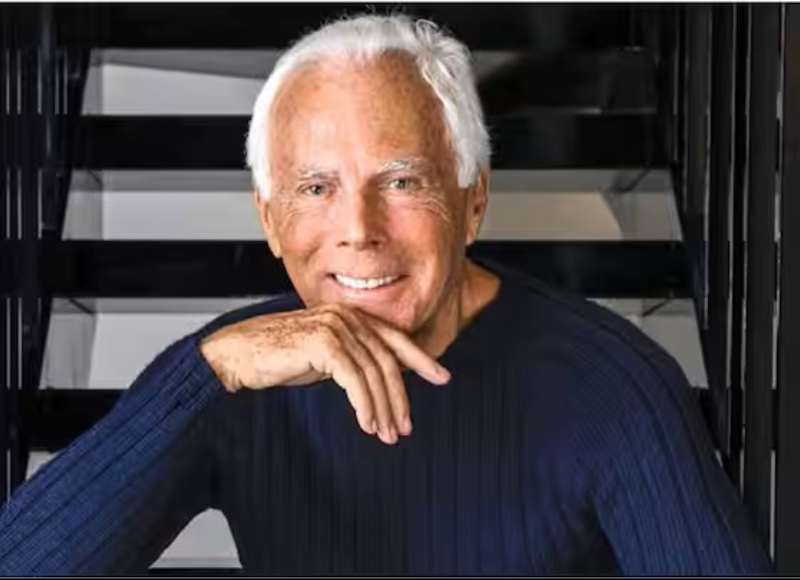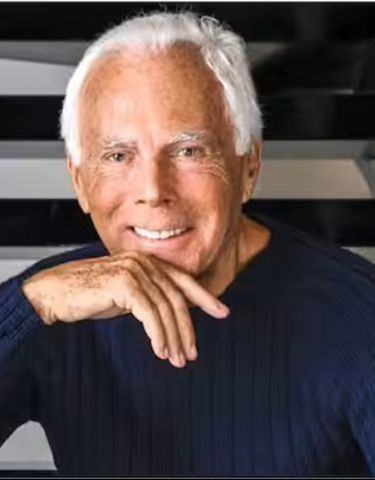Giorgio Armani’s passing at 91 marks the end of an era in fashion. As a self-made designer and entrepreneur, Armani built a global empire synonymous with elegance, discipline, and authenticity. In tribute to his life and legacy, here are 91 short lessons inspired by how “King Giorgio” managed risks in the fashion industry and stayed true to his aesthetic and values. Each lesson distills insights from his journey – from humble beginnings in war-torn Italy to the pinnacle of the fashion world – offering guidance for entrepreneurs, fashion lovers, and anyone seeking risk mitigation strategies and life strategy.
Risk Lessons from Armani’s Life and Legacy
- It’s never too late to pursue your passion. Armani founded his company at 40, proving that success can start at any age if you have the courage to begin.
- Formal education is not a requirement for greatness. He had no fashion degree – he learned by doing, mastering design through hands-on work with fabrics and industry experience.
- Embrace bold career changes. Armani walked away from medical school when he realized it wasn’t for him, a risk that opened the door to his true calling in fashion.
- Say yes to new opportunities, then learn quickly. When offered a job in a department store and later as a designer with no prior experience, he seized the chance and learned on the job.
- Use adversity to build strength. Growing up during World War II with bombings and hardship taught Armani resilience and resourcefulness early in life.
- Turn hardships into motivation. As a child he survived a near-fatal accident with an unexploded shell and endured wartime scarcity, experiences that fueled his drive rather than defeated him.
- Persevere through personal loss. After his business partner Sergio Galeotti died in 1985, Armani doubled down on work, finding new strength in tragedy and continuing their shared dream.
- Surround yourself with complementary talent. Armani’s partnership with Galeotti – the creative soul paired with a savvy businessman – showed that teaming up with those who balance your skills is a winning strategy .
- Trust the instincts of those who believe in you. It was Galeotti’s faith in Armani’s talent that convinced him to start his own label – a reminder to heed encouragement from mentors and friends.
- Build a team that shares your vision. From early on, Armani brought in family (like his sister Rosanna) and long-time collaborators, creating a circle of trust that helped safeguard his brand’s ethos.
- Be true to your signature style. Critics sometimes called his collections repetitive, but Armani stuck to his own timeless aesthetic – and clients kept coming back for it.
- Don’t chase trends for fame. He avoided being a slave to seasonal fads or press hype, focusing instead on designs that felt right to him and trusting that authenticity would win loyalty.
- Use fashion as self-expression, not validation. Armani believed in style as a reflection of self – encouraging people to use fashion to express who they are, rather than letting fashion dictate their identity.
- Elegance is in understatement. He taught that true elegance isn’t about flashy display; it’s about simplicity, intelligence, and a look that endures rather than shouts.
- Quality is the best investment. Armani held that the difference between fashion and style is quality – high standards in materials and craftsmanship were non-negotiable in his work.
- Luxury takes time. In an era of fast fashion, he reminded the industry that good things can’t be rushed – fine design and “timeless elegance” require patience and care.
- Focus on the details. To create something exceptional, Armani stressed that one must be relentlessly attentive to small details – every stitch, fabric, and fit matters in the final product.
- Innovation can be subtle. He revolutionized the suit not by loud gimmicks but by removing linings and pads, creating an unstructured look that was radically comfortable yet still classic.
- Design for real life. Armani made clothes for people to wear, not just to look at. He believed a garment’s true success is in how it fits into everyday life and enhances the wearer’s confidence.
- Let your work empower others. He saw fashion as a way to give people a better image of themselves – a boost of confidence and happiness that comes from feeling well-dressed.
- Maintain a personal touch in your brand. Armani was his own best model – often appearing in his campaigns and always wearing his own understated uniform – signaling that he lived the values he sold.
- Personal style can become a calling card. His perpetual navy T-shirt and impeccable grooming showed how a consistent personal style can reinforce your brand identity (in his case, relaxed yet elegant).
- Keep work and identity aligned. He poured his personality into his brand, ensuring that “Armani” stood for a clearly defined vision of elegance that was essentially an extension of himself.
- Work with tireless passion. Known as a workaholic, Armani treated work as the centerpiece of life – he genuinely loved what he did, which sustained him through decades of long hours and industry pressures.
- But don’t neglect self-care. In later years he admitted regretting not taking better care of himself or balancing life outside of work . Even the most driven entrepreneurs need to recharge and nurture their personal well-being.
- Learn from every role. Early jobs in window dressing and buying taught him the business side of fashion – he observed customer reactions in store aisles, gaining insights that a design school couldn’t provide.
- Immerse yourself in the craft. Armani spent hours with textile mills to understand fabrics , reflecting a belief that deep product knowledge lowers the risk of mistakes and elevates quality.
- Marry creativity with practicality. He never designed just for art’s sake; every piece had to work in the real world. This pragmatic approach kept his business profitable and his designs wearable.
- Take responsibility for decisions. A self-described perfectionist, he insisted on approving everything that carried his name . By owning each decision, he also owned every outcome – a powerful form of accountability.
- Hold your ground when you believe in something. Famously, when early critics panned a collection, he barred some press from his 1982 show – a bold move that showed he wouldn’t let outside opinions derail his vision.
- Cultivate discipline and high standards. Colleagues said working for him meant re-proving yourself every day . He set a high bar for excellence and expected others to rise to it consistently.
- Be a lifelong learner. Even as a seasoned icon, Armani stayed curious about new phenomena from social media to streetwear, observing them with interest and adapting insights that aligned with his brand.
- Adapt to cultural shifts while staying yourself. He noted how fashion had changed (e.g. the rise of streetwear and digital influence) and adjusted his strategies (like engaging younger consumers) without ever abandoning his core principles.
- Use success as a platform for good. Armani saw fame as a chance to support causes – whether donating millions to hospitals or quietly funding museum exhibitions – and preferred action over words when it came to philanthropy.
- Lead by example in crises. At the start of the COVID-19 pandemic, he was one of the first to hold a fashion show behind closed doors for safety and repurposed his factories to produce medical gowns – demonstrating moral leadership in tough times.
- Have the courage to urge change. He wrote an open letter calling out the “absurd” pace of fashion seasons and urging a return to sanity and sustainability in the industry . Sometimes managing risk means advocating for systemic change when the status quo is unhealthy.
- Stand by your ethics. He openly criticized the waste and “vulgar” excess in fashion marketing, emphasizing authenticity and a “human dimension” over spectacle . Doing what’s right may buck industry trends, but it earns respect in the long run.
- “Less is better” – quality over quantity. Armani believed the industry’s constant push for more collections was “killing fashion” and the planet; his solution was to do less, but do it better . In any business, focusing on fewer things done exceptionally can beat trying to do everything.
- Protect your brand’s integrity. He expanded into many products – from suits to hotels – but always in a way that kept the Armani identity intact . He proved you can diversify successfully if you maintain the same core values and standards across all endeavors.
- Don’t fix what isn’t broken. When asked if he’d consolidate his various lines like some competitors did, he saw no need – each line had its audience and purpose, so why create a problem where none exists? . Stick with what works for you, even if others take a different path.
- Leverage strategic partnerships. A key to his early international fame was getting Hollywood on board – from dressing Richard Gere in American Gigolo to outfitting countless Oscar attendees . He understood the immense power of aligning with influencers to elevate his brand.
- Create your own opportunities. He didn’t wait for Hollywood to come to him; he established an office in Los Angeles to court celebrities . Proactively seeking opportunity is itself a form of risk management – it puts you in the driver’s seat.
- Be savvy about marketing. Armani blurred the line between costume and fashion, lending clothes to films and stars, which in turn made his designs aspirational to the public . He knew that storytelling and image-making were as crucial as the product.
- Expand your vision of your brand. Under his name, he developed not just fashion but a lifestyle – fragrances, home decor, hotels, even chocolate and flowers . This taught the business world that a strong brand can translate into multiple streams if done carefully and authentically.
- Stay independent if it serves your vision. Armani fiercely guarded his company’s independence, rejecting buyout offers and investors that could have compromised his creative control . He valued freedom over quick expansion, ensuring he alone set the course of his brand.
- Not every offer is a good deal. Over the years he turned down lucrative suitors – even an approach from a rival luxury group – because it would dilute the brand or his control . Sometimes the business risks you don’t take (to protect your core values) are as important as the ones you do.
- Plan for the long term, not just quarterly results. He deliberately kept the Armani company “relatively small” compared to giants like LVMH, focusing on sustainable growth and symbolic projects over chasing sheer size . Long-term vision can mean resisting the pressure to grow too fast.
- Invest in what matters, not just what boosts short-term profits. Armani chose to invest in renovations of flagship stores, new boutiques, and bringing e-commerce in-house – projects of “great symbolic and practical significance” fundamental to the future . Reinvesting in your strengths fortifies your brand against future risks.
- “Small but beautiful” can beat big and bloated. By being privately owned and focused, Armani’s business stayed nimble and debt-free, with hundreds of millions in cash reserves . He proved you don’t need to be the biggest to be the best – staying lean can actually be a competitive advantage.
- Cultivate an air of exclusivity. He presented his collections in a custom-built theater in Milan, a controlled environment likened to a church for its hush and reverence . By carefully managing his brand’s presentation, he made Armani synonymous with a certain prestige and seriousness that added value.
- Balance art and commerce. Armani managed to be both a creative visionary and a shrewd businessman. He “knocked off” his own high-end designs into affordable lines successfully , showing that you can reach broader markets without cheapening your top line if you handle it intelligently.
- Learn from competition but stay in your lane. He coexisted with bold rivals (like Versace) by doing the opposite: where others went flashy, he went understated . He observed trends but always responded in a way true to his own brand DNA rather than copying others.
- Treat competitors professionally (even warmly). Despite being pitted against Versace, Armani maintained friendly terms and even attended Versace’s funeral out of respect . In business, respect and goodwill can exist alongside rivalry – burning bridges is never elegant.
- Maintain control over core operations. He kept design and management tightly in his own hands or within his trusted circle up until the end . By being deeply involved in both creative and managerial aspects, he mitigated the risk of his brand losing direction.
- Empower loyal lieutenants. Many of his senior team and family members worked with him for decades . He cultivated loyalty by trusting them with responsibility and in turn ensured continuity in his absence.
- Mentor the next generation quietly. He brought up insiders like his nieces and protégé designers under his wing rather than hiring big external names, ensuring any transition would be smooth and values-driven.
- Gradual succession beats abrupt change. Armani’s plan was a phased handover of duties to his closest collaborators over time, avoiding a sudden leadership vacuum . In any enterprise, knowledge transfer and gradual transition reduce the risk of upheaval.
- Put your plan in writing. He literally rewrote the company bylaws to take effect upon his death, detailing how the company should be governed and cautioning against reckless acquisitions . This forward-thinking step ensured his vision would legally guide the company’s future decisions.
- Use legal structures to protect your legacy. Armani established a foundation in 2016 to hold a significant stake in his company, aiming to “safeguard the governance” and values of the brand after he was gone . Structuring your business wisely can reduce legal risk, fend off unwanted takeovers and preserve what you’ve built.
- Choose continuity over quick exit. Unlike many founders who cash out, he planned for the Armani brand to live on independently beyond him. By limiting the possibility of going public or being acquired (with bylaws delaying any IPO for at least 5 years after his death) , he ensured stability through the transition.
- Identify trusted successors. He named family members and long-time colleagues as future leaders and gave them increasing responsibilities . Selecting people who understand your vision minimizes the risk of your life’s work veering off-course when you step back.
- Preserve your core principles above all. The foundation and governance he put in place explicitly aim to keep the company aligned with the principles “particularly important” to him – a reminder that values should remain the north star of any legacy plan.
- Independence can be a legacy in itself. Armani’s insistence on remaining independent has become part of his brand’s identity . He proved that a company can resist consolidation and still thrive, inspiring others to value creative freedom over merger gains.
- Manage risk by not over-leveraging. By avoiding heavy debt or outside investors, he kept financial risks low and maneuverability high. This strategy left the Armani empire financially solid even during industry recessions.
- Expand globally with cultural awareness. He extended “Italian elegance” worldwide without losing its essence . The lesson: take your unique culture or strength global, but do it in a way that respects and preserves its authenticity.
- Think beyond fashion – think lifestyle. Armani understood that his brand stood for a way of life. He ventured into hospitality (like the Armani hotels) and other fields to create a holistic Armani experience, reinforcing brand loyalty at every touchpoint .
- Consistency is king. Reviewers of his retrospective noted it was hard to tell which decade a dress was from – his style was that consistent . In business, consistency builds trust: customers knew an Armani product would always have the same timeless spirit no matter the year.
- Yet, don’t fear evolving within your niche. Over time he added softer womenswear, bold evening gowns, and more, quietly expanding what “Armani style” encompassed . He proves you can innovate within a consistent identity – evolution, not revolution.
- Protect and nurture your reputation. He carefully managed his public image, staying mostly private and letting his work speak for itself. With no scandals and a steady persona, he avoided the kind of personal risk that can tarnish a brand and give rise to reputation risks.
- Let your values guide tough decisions. Whether it was rejecting a trend he found “immoral” (like fast luxury fashion cycles ) or refusing a partnership that didn’t feel right, he consistently let his personal ethics and taste guide business calls. Principles trumped quick profit.
- Be humble about success. “Success for me isn’t a goal, but a stimulus to do better,” he once said . He treated acclaim not as an excuse to rest, but as a responsibility to continuously improve – a mindset that keeps you sharp even after big wins.
- Never think you’ve ‘made it’. Armani always believed he could raise the bar higher . He approached each new collection or project with the hunger of a newcomer, an attitude that mitigates the risk of complacency.
- Use feedback, but don’t be ruled by it. He listened to customers (as in stores early on) and noticed societal changes, but he filtered these through his own vision rather than pivoting wildly at every comment. Stay adaptable but avoid knee-jerk overreactions.
- Cultivate a loyal customer base. Armani understood his clients deeply – he knew they returned “each season for my spirit” not for passing hype . By serving your core audience consistently well, you create repeat business that is more valuable than chasing every new trend.
- Make your customers feel part of your story. Through his empathetic design philosophy (“clothes that make part of society” ), clients felt seen and valued. In any field, when people feel a product is made for them, they stick with you.
- Stay culturally tuned. From Italian neorealist films inspiring his youth to contemporary art and architecture, Armani drew ideas from the culture around him. Being aware of arts and history provided a rich, low-risk well of inspiration beyond just fashion fads.
- Find strength in your roots. He often looked to the elegance of the 1930s (the era of his childhood) for inspiration , channeling nostalgia into modern designs. Grounding innovation in something personal or historical can produce originality that still feels authentic.
- Turn personal challenges into art. Armani’s dislike of blood ended his medical career , but he later channeled his wartime experiences into designing softer, less “violent” fashion imagery – proof that even painful experiences can be alchemized into creative vision.
- Accept the burdens of leadership. He called independence “a burden but also total freedom” , acknowledging that being in charge means carrying the weight of every decision. True leaders embrace this weight rather than shying away from it.
- Foster loyalty through shared success. Many who joined him in the early years (friends, family, collaborators) stayed for decades. He gave them credit, roles, and trust, and in return they were fiercely loyal – a reminder that people stick around when they feel valued in your success.
- Keep your family close – if they earn it. Armani involved his sister, nieces, and nephew in the company , but not out of mere nepotism – they each proved themselves in roles. Family can be an asset in business when they share the vision and work ethic.
- Learn from setbacks and health scares. A bout of illness a few years before his death prompted Armani to formalize his succession plans . He used a personal setback as a trigger to strengthen his business for the future, turning vulnerability into proactive strategy.
- Share your knowledge through mentorship. Though not one to publicly teach, by example he mentored many young designers. His rigorous standards and success story have inspired generations – showing that living your values can be as instructive as formal teaching.
- Keep a global perspective. By the 21st century he expanded strongly into Asia and the Americas , recognizing the importance of new markets. He managed the risk of changing demographics by making Armani a truly global name while respecting local sensibilities.
- Stay financially prudent. Armani’s empire remained privately owned and financially sound, often reinvesting profits back into the company . He avoided the common pitfall of over-expansion with debt, which protected his company in downturns. This is an important lesson in financial risk management.
- Don’t be afraid to slow down to move forward. Later in life he advocated for slowing the fashion cycle and even extended the selling period of collections to align with seasons . In any field, sometimes stepping off the hamster wheel can restore sanity and long-term viability.
- Promote sustainability and responsibility. He openly admitted fashion’s role in climate change and urged action . Leading a business today means recognizing its impact on the world and taking steps to reduce harm – a wise risk management for the planet’s and brand’s future.
- Stay private when it counts. Armani was a famously private, even shy, person outside of work . By keeping his personal life out of the spotlight, he avoided distractions and let his work shine. Professional focus sometimes means drawing boundaries around your private sphere.
- Let your work do the talking. He wasn’t one for loud self-promotion or gimmicks; the enduring quality and style of his designs built his reputation for him. Consistent delivery on your promises builds credibility more than any marketing spin can.
- Remember that true success is measured in legacy. As he said, “Elegance is not about being noticed, it’s about being remembered” . Armani sought lasting impact over flash, focusing on work that would stand the test of time and be remembered fondly by the world.
- Live and work with integrity so your values outlive you. In the end, Giorgio Armani’s legacy is not just an empire of products, but a set of principles – independence, quality, elegance, and fearless authenticity – that will continue to inspire future generations . He showed that if you stay true to yourself, you can build something timeless.
Closing Reflections
Giorgio Armani’s life was a masterclass in balancing creativity with calculated risk, ambition with integrity. He taught us that success isn’t a sudden stroke of luck, but the cumulative result of passionate work, smart decisions, and staying faithful to one’s vision even under pressure. From Lesson 1 to 91, the common thread is an elegant resilience – a refusal to compromise on core values while adapting shrewdly to life’s uncertainties. As we reflect on his legacy, we are reminded that we too can craft a lasting “brand” in our own lives by combining hard work, authenticity, and courage. In a world obsessed with quick wins and trends, Armani’s principles encourage us to aim for enduring excellence. May his wisdom continue to inspire entrepreneurs, creatives, and dreamers to take risks thoughtfully, stand by their ideals, implement enterprise risk management and build something truly timeless.
Armani’s journey proves that with integrity and vision, one can weave a life story that remains stylish and strong, long after the final curtain call. Grazie, Giorgio, for the lessons in elegance – in fashion and in life.















